(→Powers and abilities: Condensed and clarified it. And as much as I like science, I removed much wordy technobabble that's inappropriate for this site. Really? Talking about the mass of the actual Sun?!) Tag: Visual edit |
m (→Lords of the Valar: Corrected to singular of Valar; i.e, Vala) Tag: Visual edit |
||
| Line 26: | Line 26: | ||
=== Lords of the Valar === |
=== Lords of the Valar === |
||
* [[Manwë|Manwë Súlimo]], the Wind-king and the King of the Valar. |
* [[Manwë|Manwë Súlimo]], the Wind-king and the King of the Valar. |
||
| − | *[[Melkor|Melkor (Morgoth Bauglir)]], the [[Dark Lord|Lord and Creator of Dark Powers]] who, when he was counted as a |
+ | *[[Melkor|Melkor (Morgoth Bauglir)]], the [[Dark Lord|Lord and Creator of Dark Powers]] who, when he was counted as a Vala, was most powerful of them |
* [[Ulmo]], the Sea-king and the Lord of Water |
* [[Ulmo]], the Sea-king and the Lord of Water |
||
* [[Aulë]], the Smith and the Lord of Earth and all that's underneath |
* [[Aulë]], the Smith and the Lord of Earth and all that's underneath |
||
Revision as of 07:34, 22 July 2019
Template:Infobox Race
Middle-earth during the Years of The Lamps
The Valar (Quenya; singular Vala) were the Powers of Arda who shaped and rule the world. They lived on the Western continent of Aman.
History
The Valar were the fourteen Ainur who, after being molded of Eru's thought, entered Arda after its creation, to give order to the world and combat the new evils of Melkor. They had helped to begin the shaping of Arda through the music of Ilúvatar, and often referred to one another as "brother" or "sister". Each of the Ainur had added his or her own part to the music creating the world incarnate, save for Melkor, who at the time was counted as the strongest of them. His vision of what Arda should have been differed from Eru's, which led to his banishment and great rebellion that would cause most of the ills of the world of Arda.
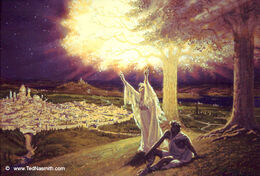
Varda and Manwë, by Ted Nasmith
The fourteen Valar originally dwelt on Almaren, a hidden island on the "Great Lake", but after it was destroyed and the earth was reshaped, long before the Awakening of the Elves, they relocated to Aman and founded the realm of Valinor.[1] They would become known as the 'Powers of the World', though rarely directly intervening in the world's course of events. Eru instead gave them delegation of Arda, and so at Valinor they constructed the golden city of Valimar, their own mansions dispersed cross the plain; and Máhanaxar, the "Ring of Doom", at which they would confer and hold counsels.
Eru created for them lesser heavenly beings named the 'Maiar', who were their servants. Though subordinate to the Valar, the Maiar were powerful nonetheless, and included Melian, Sauron (named Mairon), Olórin (later named Gandalf) and the other Istari, and those who would become the Balrogs. Most Maiar were associated with particular Valar: Ossë and Uinen, the "powers of the oceans", served under Ulmo, while Curumo (much later known as Saruman), served Aulë the Smith. Sauron also served Aulë before he was corrupted by Melkor.
It was originally Melkor's intention to rule Arda for himself, but Manwë, the superior of the Valar, called other spirits to help him confront Melkor. (Among these were the other Valar and the Maiar.) Melkor withdrew from Arda after the short War for Sake of the Elves, and the Valar continued their creation and furnishing of the World, while Melkor plotted to return and regain dominance. In time, once he returned in secret and ruined the Two Trees of Valinor with Ungoliant, Valinor lost its light, and the Valar eventually set to creating the Sun and Moon in the sky.
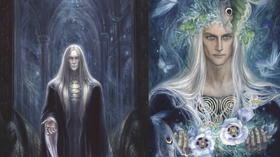
Depiction of Mandos and Lórien, the Fëanturi
The War of the Jewels was prompted after Fëanor refused to forfeit his Silmarils to the Valar, for the rekindling of the Two Trees. He ended his and the Ñoldor's allegiance with the Valar, and bore a new conflict between the Elves and Melkor.[2] The Valar soon fortified their realm, and brought about the "Hiding of Valinor", preventing Melkor and Fëanor and his followers from entering. The conflict between Melkor and the Valar was not resolved until the war's climax, during which the Valar came physically into Beleriand, helped conquer Melkor's forces at Angband, and captured him. He was taken to Aman and cast behind the Door of Night.[3]
In the Second Age, the Valar created anew the island of Elenna in the middle of the Sea, for the noble peoples of the Edain who had resisted and endured the war against Melkor. On this island was established the kingdom of Númenor, which lasted three millennia until their king Ar-Pharazôn attempted to contravene the Ban of the Valar. The Valar sank the island, and the living Númenóreans sailed eastward, and settled Middle-earth.
Once Sauron had begun to regain power in Middle-earth after his defeat in the War of the Last Alliance, the Valar sent an order of five Maiar, the "Istari", unto Middle-earth, to provide a strong opposition to Sauron until his final destruction.
Names
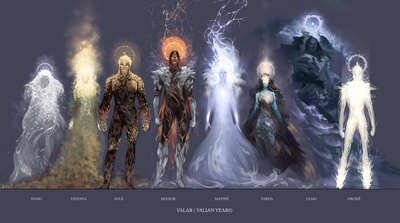
Portrayal of the Aratar
These are the names of the Valar as they were known to the Eldar. In Middle-earth, they were known by other names of Sindarin origin; for example they called Varda Elbereth. Men knew them by many other names, and sometimes worshiped them as Gods. The Elves called Varda, the creator of the stars, Elentári. The dwarves called Aulë, their creator, Mahal. The Ents called Yavanna, their creator, Kementári. It should be noted that, with the exception of Oromë, the names listed below are not actual names but rather titles: the true names of the Valar are nowhere recorded. Male Valar are called "Lords of the Valar"; females are called "Ladies of the Valar," or Valier. Among these exist six married couples, with only Ulmo and Nienna remaining single.
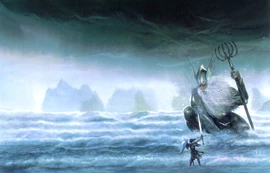
Lords of the Valar
- Manwë Súlimo, the Wind-king and the King of the Valar.
- Melkor (Morgoth Bauglir), the Lord and Creator of Dark Powers who, when he was counted as a Vala, was most powerful of them
- Ulmo, the Sea-king and the Lord of Water
- Aulë, the Smith and the Lord of Earth and all that's underneath
- Oromë Aldaron, the Huntsman, the Lord of Forests and the Great Rider (husband of Vána)
- Námo (Mandos), the Doomsman and the Judge of the Dead (husband of Vairë)
- Irmo (Lórien), Lord and Master of Dreams, Visions, and Desires, and Creator of the Oloré Mallé, or Path of Dreams (husband of Estë).
- Tulkas Astaldo, the Wrestler, the Champion of Valinor, and last of the Valar to come to Arda (husband of Nessa)
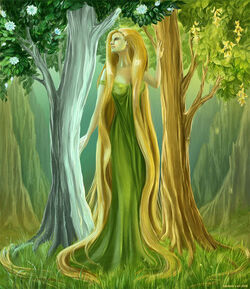
Yavanna, the Queen of the Earth, by Sedeptra
Ladies of the Valar
- Varda Elentári, the Star-queen and the Queen of the Valar
- Yavanna Kementári , the Fruit-Giver and the Lady of Earth
- Nienna, the Weeper and the Lady of Mercy
- Estë the Gentle, Lady of Healing and Rest, and spouse of Irmo
- Vairë, the Weaver and spouse of Mandos
- Vána, the Ever-young and spouse of Oromë
- Nessa, the Dancer and spouse of Tulkas
Other names
The Aratar (Sindarin: Exalted) or High Ones of Arda were the eight greatest of the Valar: Manwë, Varda, Ulmo, Yavanna, Aulë, Mandos, Nienna, and Oromë. Melkor, the most powerful of all, is not counted among them. Lórien and Mandos were brothers, and would be referred to together as the Fëanturi or "Masters of Spirits".
In earlier versions of the legendarium, "Gods" was a word used often to refer to them [4], and Valur and Valir for a short time denoted male and female Valar.[5]
Powers and abilities
Like the other Ainur, the powers of the Valar were ambiguously mysterious. The Valar had similar, though superior, abilities to the Maiar, such as the controlling light and of fire, transforming into many forms, or trancing Man or Elves their presence. Manwë and Ulmo controlled the winds and waters of Arda, respectively. Yavanna and Nessa created the Two Trees, Laurelin and Telperion, to illuminate much of Aman. Varda could realign stars into constellations that prophesied the doom of Morgoth
See also
Trivia
- The Valar are based on the gods of classical mythology, such as Zeus, Hephaestus, Demeter and Poseidon.
Translations around the World
| Foreign Language | Translated name |
|---|---|
| Amharic | ቫላር |
| Arabic | فألار |
| Belarusian Cyrillic | Валар |
| Bengali | বলার |
| Bosnian | Valari |
| Bulgarian Cyrillic | Валари |
| Catalan | Vàlar |
| Chinese (Hong Kong) | 維拉 |
| Croatian | Valari |
| Estonian | Valarid |
| Georgian | ვალარები |
| Greek | Βάλαρ |
| Gujarati | વેલર |
| Hebrew | ולאר |
| Hindi | वलर |
| Hungarian | Valák |
| Japanese | ヴァラ |
| Kannada | ವ್ಯಾಲರ್ |
| Kazakh | Валар (Cyrillic) Valar (Latin) |
| Korean | 발라 |
| Kyrgyz Cyrillic | Валар |
| Macedonian | Валар (Cyrillic) Valar (Latin) |
| Marathi | वलर |
| Mongolian | Валар (Cyrillic) Valar (Latin) |
| Nepalese | वाल्टर |
| Pashto | ویلر |
| Persian | والار |
| Polish | Valarowie |
| Russian | Валар |
| Serbian | Валари (Cyrillic) Valar (Latin) |
| Sindhi | والار |
| Sinhalese | වාලර් |
| Tajik Cyrillic | Валари |
| Tamil | வளர் |
| Telugu | వళర్ |
| Ukrainian Cyrillic | Ва́лари |
| Urdu | والر |
| Uzbek | Валар (Cyrillic) Valar (Latin) |
| Yiddish | וואַלאַר |
References
- ↑ The Silmarillion, Quenta Silmarillion, Ch. I: "Of the Beginning of Days"
- ↑ The Silmarillion, Quenta Silmarillion, Ch. IX: "Of the Flight of the Noldor", pg. 85
- ↑ The Silmarillion, Quenta Silmarillion, Ch. XXIV: "Of the Voyage of Eärendil and the War of Wrath"
- ↑ The History of Middle-earth, Vol. I: The Book of Lost Tales Part One, Index, entry "Gods"
- ↑ The History of Middle-earth, Vol. I: The Book of Lost Tales Part One, chapter II: "The Music of the Ainur", Notes, pg. 61
